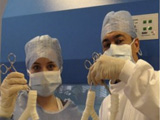|
|
TODAY.AZ / Weird / Interesting
Using a lab-grown trachea, surgeons conduct the world's first synthetic organ transplant
08 July 2011 [15:12] - TODAY.AZ
 Surgeons working at Karolinska University Hospital in Sweden have taken a huge step forward for regenerative medicine by successfully executing the world’s first synthetic organ transplant. The donor-less transplant saved the life of a 36-year-old cancer patient, who is doing well now after having received a new windpipe grown from his own stem cells.
Surgeons working at Karolinska University Hospital in Sweden have taken a huge step forward for regenerative medicine by successfully executing the world’s first synthetic organ transplant. The donor-less transplant saved the life of a 36-year-old cancer patient, who is doing well now after having received a new windpipe grown from his own stem cells.This story is about as international as it gets: The Eritrean patient, Andemariam Teklesenbet Beyene, was pursuing his doctorate in geology in Iceland when his trachea was consumed by an inoperable tumor that grew so bad that it was actually blocking his breathing. So 3-D scans of his windpipe were sent to scientists at University College London, which crafted a glass scaffold that was a perfect match for Beyene’s trachea and two main bronchi.
The scaffold was in turn was sent to Sweden, where it was soaked in stem cells from Beyene’s own bone marrow. The stem cells took hold and within just two days had filled the scaffold, creating a new trachea that is, biologically speaking, Beyene’s own tissue. A 12-hour operation by an Italian surgeon specializing in trachea operations removed Beyene’s windpipe and all signs of the cancer and then replaced it with the new, lab-grown organ.
That was a month ago. Today, Beyene is recovering well. Because the organ was grown from his own cells, there is no risk of his body rejecting it and no need for the harsh regimen of anti-rejection drugs that usually go hand in hand with an organ transplant. Moreover, there was no need to seek out a donor. In Beyene’s case, that was key. The tumor was increasingly blocking his breathing, and without the transplant he would have died. The clock was ticking, as it so often is in transplant situations.
From stem cell solution to transplantable organ in two days? That’s nothing short of amazing. Moreover, this is just the tip of the iceberg. Theoretically, this kind of procedure could be used to regenerate all kinds of different organs for transplant, eliminating the need (and wait) for donor organs and reducing the complications inherent in them.
/Popular Science/
URL: http://www.today.az/news/interesting/89964.html
 Print version
Print version
Views: 2610
Connect with us. Get latest news and updates.
See Also
- 19 February 2025 [22:20]
Visa and Mastercard can return to Russia, but with restrictions - 05 February 2025 [19:41]
Japan plans to negotiate with Trump to increase LNG imports from United States - 23 January 2025 [23:20]
Dubai once again named cleanest city in the world - 06 December 2024 [22:20]
Are scented candles harmful to health? - 23 November 2024 [14:11]
Magnitude 4.5 earthquake hits Azerbaijan's Lachin - 20 November 2024 [23:30]
Launch vehicle with prototype of Starship made its sixth test flight - 27 October 2024 [09:00]
Fuel prices expected to rise in Sweden - 24 October 2024 [19:14]
Turkiye strikes terror targets in Iraq and Syria - 23 October 2024 [23:46]
Kazakhstan supplied almost entire volume of oil planned for 2024 to Germany in 9 months - 23 October 2024 [22:17]
Taiwan reported passage of Chinese Navy aircraft carrier near island
Most Popular
 What von der Leyen doesn't know about. Or doesn't want to know
What von der Leyen doesn't know about. Or doesn't want to know
 Culture Minister meets with Kyrgyz counterpart in Bishkek
Culture Minister meets with Kyrgyz counterpart in Bishkek
 Trump sees hope for Ukraine-Russia deal, analysts remain skeptical
Trump sees hope for Ukraine-Russia deal, analysts remain skeptical
 Leyla Aliyeva visits school for visually impaired in Hanoi
Leyla Aliyeva visits school for visually impaired in Hanoi
 Pakistani PM hails Lahore-Baku direct flights as key milestone
Pakistani PM hails Lahore-Baku direct flights as key milestone
 Baku to Host Second Turkic Trade and Investment Forum in June
Baku to Host Second Turkic Trade and Investment Forum in June
 Baku court resumes trial of Armenian-origin individuals accused of war crimes
Baku court resumes trial of Armenian-origin individuals accused of war crimes
